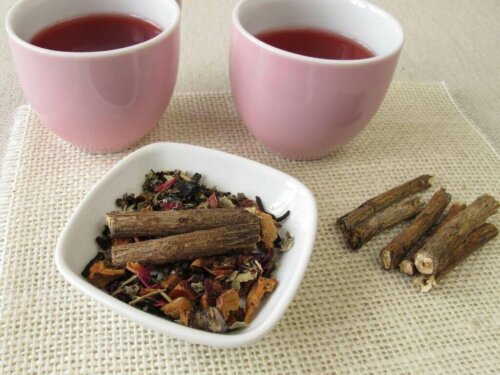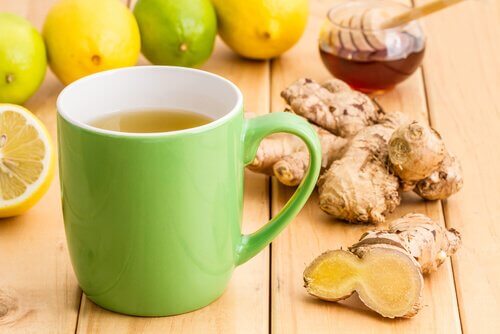How to Make Three Expectorant Cough Remedies

In this article, we’ll be sharing three expectorant cough remedies. With natural ingredients, you can promote mucus elimination and provide great relief in cases of flu or colds.
Read on to discover step-by-step recipes, as well as the healing properties of the medicinal ingredients they contain. However, we always recommend seeing and consulting your doctor before following any treatment.
Three expectorant cough remedies
1. Licorice and fennel infusion

Licorice is a natural home remedy you can use to treat different conditions. Among its positive benefits, we can highlight its expectorant, cough suppressant, antiviral, and demulcent effects. It’s an antimicrobial medicinal plant that’s very suitable for all types of respiratory infections.
In addition, fennel is also a good expectorant and a very common cough remedy in colds and flu. Therefore, you can combine both plants in a very effective medicinal infusion.
Ingredients
- 1 teaspoon of freshly chopped licorice root (5 g)
- A tablespoon of fennel seeds (5 g)
- 1 cup of water (250 ml)
Preparation
- Firstly, boil the licorice and fennel in the water for five minutes.
- After that, cover the pot and let it stand for 10 minutes.
How to drink
- Drink this infusion while it’s still hot to take full advantage of its benefits, if possible on an empty stomach, up to two to three times a day.
- However, people with high blood pressure should always take it under medical supervision, as licorice can elevate blood pressure.
You should also read: Calm Your Cough with These 5 Homemade Expectorants
2. Expectorant cough remedies: Southern blue gum steam

Southern blue gum (Eucalyptus globulus) is the most widely used medicinal plant for respiratory conditions. Experts recommend it in cases of colds, mucus, a cough, asthma, and a sore throat. Also, people use it topically to massage their upper back and chest.
Ingredients
- 2 tablespoons of southern blue gum leaves (18 g)
- 4 cups of water (1 liter)
Preparation
- Firstly, boil the southern blue gum leaves in the water for 10 minutes.
- Then, turn off and start to inhale the steam, at least 11 inches away from your face. You can breathe it in through your nose and mouth.
- Put a towel or blanket over your head to create a sauna effect.
Also, you can uncover your neck and chest a little to achieve a direct effect on that area. - Inhale the steam several times and, if necessary, reheat the mixture.
- When you’re done, don’t forget to bundle up!
- In addition, you can repeat this treatment several times a day.
How to make the steam
Eucalyptus has very positive benefits. Nevertheless, it also has some contraindications and side effects when ingested. For this reason, steam is much more recommended, even for children.
Read on to learn more: How to Make Cough Syrup out of Thyme and Licorice
3. Ginger, honey, Ceylon cinnamon, and cayenne pepper syrup

The last of these expectorant cough remedies is a syrup that you can make at home. The best part is that its ingredients are natural and have many medicinal properties.
This syrup contains four ingredients:
- Firstly, ginger. It’s expectorant and heats up the chest.
- Secondly, Ceylon cinnamon. Expectorant, anti-inflammatory, and antiviral.
- Thirdly, cayenne pepper. Boosts the immune system and fights congestion.
- Finally, honey. Natural antibiotic, bactericidal, and antiseptic. In addition, it relieves coughs and facilitates phlegm elimination.
Ingredients
- 4 tablespoons of freshly grated ginger (40 g)
- 1 tablespoon of Ceylon cinnamon powder (15 g)
- ½ teaspoon of cayenne pepper (2 g)
- 1 cup of honey (340 g)
- 2 cups of water (500 ml)
Preparation
- For starters, boil all the ingredients, except the honey, in a pan over low heat for at least half an hour.
- After that, strain the medicinal plants and only bring the already strained mixture to a boil, along with the honey.
- Then, leave the pot uncovered for 15 minutes so that the water evaporates and so the syrup gains texture.
- Finally, let it cool and store in an airtight container in the fridge.
How to take the syrup
- Take one tablespoon half an hour before each meal, on its own or mixed with hot water.
Now you know three homemade and easy ways to make expectorant cough remedies. They’ll help you to soothe this respiratory condition in an effective way! However, we always recommend seeing your doctor and following all their recommendations.
All cited sources were thoroughly reviewed by our team to ensure their quality, reliability, currency, and validity. The bibliography of this article was considered reliable and of academic or scientific accuracy.
- Nair, S. S., Pharande, R. R., Bannalikar, A. S., & Mukne, A. P. (2015). In vitro antimycobacterial activity of acetone extract of Glycyrrhiza glabra. Journal of Pharmacy & Pharmacognosy Research.
- Gupta, S. kumar, & Sharma, A. (2014). Medicinal properties of ginger (Zingiber officinale Roscoe) – a review. Journal of Pharmacy and Biological Science.
- Mulyaningsih, S., Sporer, F., Reichling, J., & Wink, M. (2011). Antibacterial activity of essential oils from Eucalyptus and of selected components against multidrug-resistant bacterial pathogens. Pharmaceutical Biology. https://doi.org/10.3109/13880209.2011.553625
- Oduwole, O., Meremikwu, M. M., Oyo-Ita, A., & Udoh, E. E. (2014). Honey for acute cough in children. Evidence-Based Child Health. https://doi.org/10.1002/ebch.1970
- Saeed, S., & Tariq, P. (2008). Cinnamon (Cinnamomum zeylanicum L.). International Journal of Biology and Biotechnology.
This text is provided for informational purposes only and does not replace consultation with a professional. If in doubt, consult your specialist.








